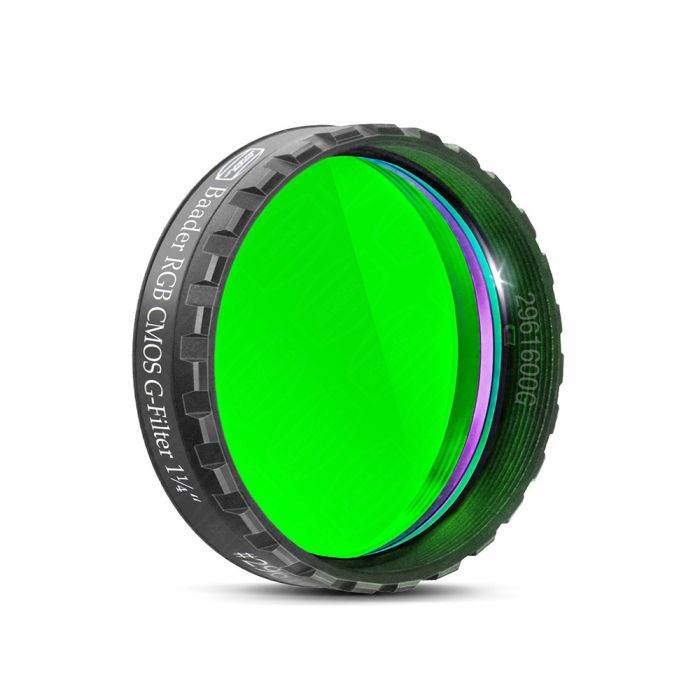Baader 1.25" CMOS Optimized Green Filter
Baader 1.25" CMOS Optimized Green "G" Filter
Best suited for imaging O-III emission line objects using CMOS monochrome cameras, this 1.25" Green "G" filter transmits wavelengths between 490 nm and 580 nm. Despite the fact that the "G" and "B" filter overlap, crucial H-Beta and O-III emission lines remain clearly independent from one another. Although there are no critically important emission lines to be found in the vicinity of 580 nm, Mercury and Sodium vapor street lights do emit from this region. However, thanks to Baader's RGB filter design, these unfavorable emissions are cut off almost entirely, resulting in a darker sky background as well as better color balance and separation.
Baader 1.25" CMOS Optimized Green "G" Filter Highlights
- Suitable for use with a large array of telescopes, including those featuring focal ratios between f/15 and f/1.8, this Baader 1.25" Green "G" Bandpass Filter is optimized for CMOS imaging cameras.
- Transmission is remarkably high in order to decrease stray light and reflections to extraordinarily low levels.
- A balanced design allows the capture of subframes with identical 1:1:1 exposure times, essential for automated imaging applications.
- Enhanced contrast comes courtesy of steep slopes at all transmission curves.
- Separately coated rather than carved out of a larger glass plate, this Baader 1.25" green filter has been planeoptically polished with Reflex-Blocker™ hard coatings and Life-Coat™ sealed coating edges.
- This parfocal filter meets the current standards for filter thickness.
- The entire circumference contains blackened edges with black outer rim on the telescope side that acts as a filter-lead-side-indicator to prevent reflections resulting from light emissions spilling onto the edge of the filter.
- Using the "B" and "G" filters together doubles the energy emitted from the O-III line, leading to the utmost peak transmission for the best possible deep sky S/N yield.
- The “G” and “R” filters both block undesirable light coming from Mercury and Sodium vapor street lamps emitting at 580 nm, thus enabling peak color balance and separation, as well as a blacker sky background.
- Suitable for use with older CCD cameras despite being designed specifically with modern CMOS technology in mind.
More about Baader CMOS Optimized RGB Filters
Astro-imaging with modern CMOS cameras using Baader RGB color filters is achievable for nearly all telescopes independent of optical speed. In fact, these filters are compatible with any telescope that has a focal ratio between f/15 and f/1.8. Notable features include a balanced design, steep slopes at all transmission curves, blackened lens edges with telescope-sided black outer rim around the entire circumference. Highly coveted 1:1:1 subframe exposures, a must for automated imaging, are realized due to this filter's balanced design. Remarkably low levels of stray light and reflections, as well as peak color contrast that matches regular CMOS QE and s/n ratio, are both attainable through steep transmission curve slopes. Finally, unwanted reflections are lessened even further thanks to blackened lens edges with black outer rim on the telescope side that serve as a filter-lead-side-indicator.
Contrary to filters produced by other manufacturers which are cut from a larger plate of glass causing them to form micro-cracks around all edges, these Baader RGB color filters are individually coated and planeoptically polished with Reflex-Blocker™ hard coatings. This prevents premature aging via moisture build-up. In addition, these filters feature Baader Planetarium's own even harder Life-Coat™ coatings that will keep your filters from acquiring damage caused by unfriendly environmental conditions. With Life-Coat™, your filters boast the durability necessary to hold up over many years despite repeated proper cleanings. Designed with notable regard for parfocality, these filters conform to current standards in terms of thickness.


